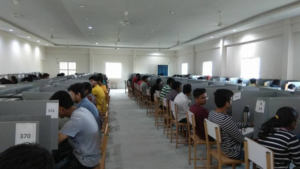Dear IBPS Clerk Aspirants,
The reasoning is a game of wits and presence of mind! Yes, it is true and it might seem as the greatest of the challenge after English Section’s surprises but yet this one can easily be dealt with. You just need correct practice and hardwire your brain to quickly make decisions about what to attempt and what to leave. And for same we are providing you questions of Reasoning Question and Answers. Solve these to Practice latest pattern reasoning question for bank exams.
Directions (1-5): Study the following information to answer the given question.
In a certain code,
“her idea has merit” is written as “fo la bu na”,
“merit list has been displayed” is written as “jo ke la si na”,
“her name displayed there” is written as “ya si bu zo” and
“name in merit list” is written as “na ya go ke”.
Q1. What does “ke” stand for ?
(a) been
(b) has
(c) merit
(d) name
(e) list
Q2. What is the code for “idea” ?
(a) fo
(b) la
(c) bu
(d) na `
(e) Either bu or na
Q3. Which of the following represents ‘name has been displayed’ ?
(a) ya la ke si
(b) jo si ya la
(c) si jo ke na
(d) bu ya ke la
(e) ya si jo zo
Q4. What does “zo” stand for ?
(a) there
(b) displayed
(c) name
(d) her
(e) cannot be determined
Q5. Which of the following may represent ‘her name is there’ ?
(a) zo ya go wo
(b) bu ya zo go
(c) zo ya bu ke
(d) ya zo wo bu
(e) wo go zo ya
Directions (6-10): Read the following information carefully and answer the questions given below:
Nine teachers A , B, C, D, E, F, G, H, and I are living in a same building of nine floor counting from one to nine. Ground floor is numbered 1 and so on . They all teach different subjects i.e Reasoning, Maths, Computer, English, Current Affairs, Hindi, Banking, Geography, and History but not necessarily in the same order. There are three floors between A and I, who teaches Current Affairs . A lives one of the above floor on which I lives. H teaches Computer and he lives immediately above the floor on which A lives. There is only one floor between H and G, who teaches English . F teaches Maths and he lives below the floor on which G lives. F does not live on even number floor. There is only two floors between F and E, who teaches Reasoning . B teaches Geography and lives below the floor on which F lives. B lives on even number floor. There are as many as floor between B and one, who teaches Hindi and as between A and C . A does not teach Banking . I does not live on second floor. A lives on even numbered floor.
Q6.How many teachers are living below the floor on which the teacher who teaches Banking?
(a) Four
(b) Three
(c) No one.
(d) One
(e) Five
Q7. D lives on which of the following floor?
(a) First
(b) Second
(c) Third
(d) Fourth
(e) Fifth
Q8. H is related to English and C is related to Maths, in the same way F is related to?
(a) Banking
(b) Geography
(c) Current Affairs
(d) Hindi
(e) None of these
Q9. Who among following lives on seventh floor?
(a) G
(b) H
(c) E
(d) A
(e) C
Q10. How many floors are there between the E and the floor on which F lives?
(a) Two
(b) Three
(c) Four
(d) One
(e) None of these
Directions (11-15): In these questions, symbols @, #, %, $ and * are used with different meanings as follows:
‘A @ B’ means ‘A is not smaller than B’.
‘A # B’ means ‘A is neither smaller than nor equal to B’.
‘A % B’ means ‘A is not greater than B’.
‘A $ B’ means ‘A is neither greater than nor equal to B’.
‘A * B’ means ‘A is neither smaller than nor greater than B’.
Now in each of the following questions assuming the given statements to be true, find which of the three conclusions I, II and III given below them is/are definitely true and give your answer accordingly.
Q11.Statements: J # H, H * T, T $ R, R % F
Conclusions:
I. J # R
II. R # F
III. J # T
(a) Only I is true
(b) Only I and II are true
(c) Only III is true
(d) All are true
(e) None of these
Q12.Statements: E $ P, P % H, H @ I, I # K
Conclusions:
I. P * I
II. I % E
III. H % K
(a) Only I is true
(b) Only II is true
(c) Only III is true
(d) Only I and II are true
(e) None is true
Q13.Statements: L @ K, K # R, R $ H, H % N
Conclusions:
I. L # R
II. N # R
III. L * N
(a) Only I and II are true
(b) Only either I or II is true
(c) Only II and III are true
(d) Only III is true
(e) None of these
Q14.Statements: T $ V, V % K, K * L, L % H
Conclusions:
I. V % H
II. T $ L
III. T $ H
(a) Only I and II are true
(b) Only II and III are true
(c) Only I and III are true
(d) All are true
(e) None of these
Q15.Statements: V @ W, W # D, D $ M, M % F
Conclusions:
I. V # D
II. F # D
III. V * F
(a) Only I is true
(b) Only II is true
(c) Only either I or II is true
(d) Both I and II are true
(e) None of these
You May also like to Read:





 GA Questions Asked in IBPS RRB PO Mains ...
GA Questions Asked in IBPS RRB PO Mains ...
 IBPS RRB PO Mains Exam Analysis 2025, Al...
IBPS RRB PO Mains Exam Analysis 2025, Al...
 IBPS RRB PO Mains Exam Analysis 2025, 28...
IBPS RRB PO Mains Exam Analysis 2025, 28...








